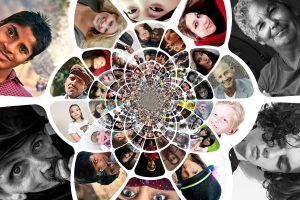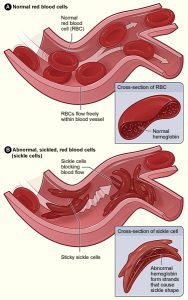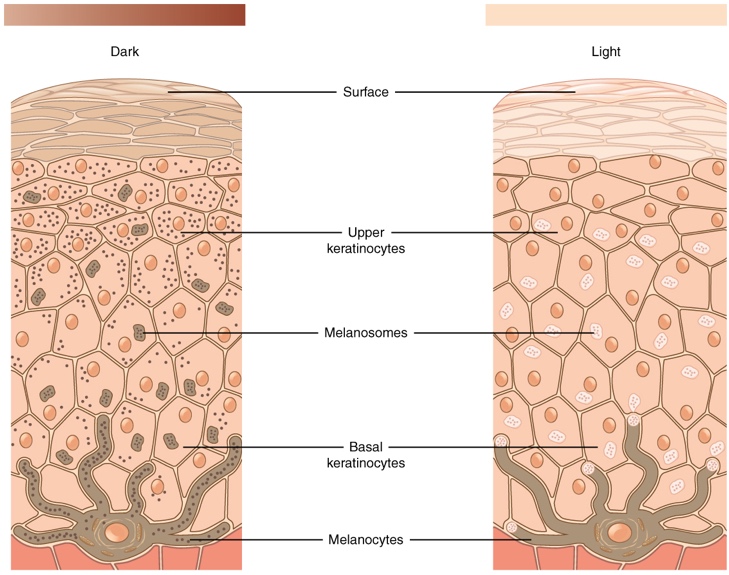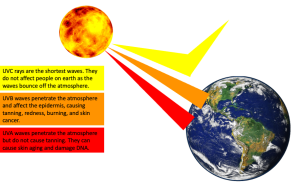6 How Do Humans Differ?

We can look around any place we are at with other humans and see variation, both biological variation and cultural variation. This chapter will focus on why there is biological variation in human populations. This necessitates a discussion of not only biological explanations, but cultural and environmental explanations as well. We will explore why there are different allele frequencies in populations and how that is related to adaptive significance.
Human Variation
Genetic Variation
When thinking about human variation, it is difficult not to think about Salt ‘n’ Pepa’s 1990 hit, “Let’s Talk about Sex” (Blacks’ Magic album; released by Next Plateau records). The act of sexual reproduction is critical in the production of human variation from a genetic level to a cultural level, e.g., rules for mate choice.
“All humans share mostly identical genetic material—100% of the same genes and 99.9% of their variations…almost all our species’ genetic variations are found within populations, not between them” (Welsch et.al. 2017, 265). Data from the Human Genome Project, which began in 1990, and subsequent research projects indicate that “between 83 and 97% of genetic variation is found within human populations and between 3 and 17% is found between populations” (Welsch et.al. 2017, 266). Why is this?
Recall in chapter 3, we discussed meiosis, the process of cell division in sex cells. Eggs and sperm each carry half of our parents’ chromosomes. When an egg is fertilized by a sperm a zygote is formed with a full complement of chromosomes. The mix of the chromosomes is random (we cannot know which our parents’ chromosome we will get) which is why offspring look similar to their parents but may look more like one parent than another or not. Plus, genes may exchange genetic material in a process called recombination, creating a new genetic mix in offspring. Other forces of evolution also contribution to variation. Mutations can cause new genetic variants to arise. Genetic drift, which occurs in small populations isolated through either geography or cultural behavior, will make populations different from one another but cause less variation within a population. Gene flow, the exchange of genetic material between populations, causes a decrease in variation and is a primary explanation of why contemporary humans are so alike genetically. We can use genetics to track Pleistocene AMH migration patterns out of Africa and through the rest of the world. As glaciers melted, populations in Australia, New Guinea, and the Americas became isolated for a short time, allowing genetic drift to impact their genetic makeup. As better modes of travel were invented, gene flow would once again impact populations the world over.


One reason humans are so alike genetically is because there have been a few genetic bottlenecks, a form of genetic drift. Bottlenecks are caused by events that wipe out a part of the gene pool, leaving less genetic variation. Computer modeling suggests there were two major bottlenecks that affected the evolution of AMH, one as AMH left Africa and entered the Middle East and a second one as people crossed Beringia for the Americas (Hellenthal et.al. 2008). There was also a Y-chromosome bottleneck across the Old World about 5 kya to 7 kya, possibly due to competition between patrilineal groups (Zeng et.al. 2018). You will learn about patrilines in the next chapter. Any time variability in the gene pool declines, the members of the population become more alike.
Cultural Practices and variation

There are cultural practices such as mate choice that affect genetic variability. Sometimes mate choice comes down to proximity. In the past, it took people a good chunk of time to get from point A to point B. For instance. it was not too long ago that people living on the east side of Lake Washington took three days to get to Seattle because they had to walk or ride a horse around the lake. Many people opted to choose their partners from close to home, although there were still rules about who you could and could not marry. One cultural universal is the incest taboo, meaning that close relatives are not in the pool of potential mates. While there have been historical exceptions to the incest taboo, mostly within royal families where they wanted to ensure the royal bloodline, for the vast majority of people mating with close blood relatives is prohibited. Incest is a form of endogamy, a cultural practice where you are expected to choose your mate from within a specific group. For instance, some religions expect their adherents to choose a mate who is also a member of the religion, e.g., the Ashkenazi and the Amish. Groups who practice exogamy must choose a mate outside of a specified group, e.g., the Yanomami must choose a mate from outside of their village.
In biology, the terms positive assortative and negative assortative mating are used to describe similar concepts. Positive assortative mating occurs when an individual chooses a partner similar to themselves. It could be based on cultural similarities, like religion, or physical characteristics. An extreme example is eugenics, where people are encouraged to choose partners with specific physical characteristics (think the Nazi party and the Aryan “race”—a concept we will return to shortly). Negative assortative mating is the opposite, and mates are chosen with dissimilar traits, e.g., a very tall person choosing a very short person. All these partner choice practices impact the variability of the gene pool.
Disease and Variation

Diseases can also cause differing allele frequencies in populations. Sickle cell disease is a blood disease caused when an individual has two recessive hemoglobin-Beta alleles. This causes the individual’s red blood cells to become stiff and form a sickle shape. These sickled cells cannot transport the necessary oxygen and are easily destroyed, thus resulting in anemia and damaged vital organs and tissue. Acute chest problems, severe pain episodes, bacterial infections and stroke are common symptoms. Reproduction is also negatively impacted. Theoretically, natural selection should have eradicated this disease from populations, but it did not. Research shows that sickle cell remains in populations where malaria is endemic. In its severe form, malaria is lethal. Malaria is a disease caused by parasites carried by female anopheles mosquitoes. When they bite an infected individual, they transfer the parasite which proliferates in red blood cells. If a person has sickle cell disease, the parasites cannot survive in the sickled cells so the individual cannot catch malaria. People who have two dominant copies of the hemoglobin-Beta allele can more easily catch malaria, again, if it the severe form, they may die, but even milder cases of malaria can negative impact someone’s ability to reproduce. If a person is a carrier of sickle cell disease, meaning they have one copy of the recessive allele and one copy of the dominant allele, they may catch a mild case of malaria, but it is not life threatening. So, in the case of sickle cell disease, the reproduction of people who have a copy of the recessive and dominant allele is not negatively impacted. Because of this situation, called a balanced polymorphism, the disease, in this case sickle cell, stays in the population.
Environment and Variation
Humans have biological plasticity, or an ability to adapt biologically to the environment. An adaptation is any variation that can increase one’s biological fitness in a specific environment; more simply it is the successful interaction of a population with its environment. Adaptations may be biological or cultural in nature. Biological adaptations vary in their length of time, anywhere from a few seconds for a reflex to a lifetime for developmental acclimatization or genetics. The biological changes that occur within an individual’s lifetime are also referred to as functional adaptations.

What type of adaptation is activated often depends on the severity and duration of stressors in the environment. A stressor is anything that disrupts homeostasis, which is a “condition of balance, or stability, within a biological system…” (Jurmain et al 2013: 322). Stressors can be abiotic, e.g., climate or high altitude, biotic, e.g., disease, or social, e.g., war and psychological stress. When the body experiences a stressor, a strain occurs. At that point, a response is initiated. Sometimes an immediate response is initiated, such as shivering when we are cold. Putting on a coat when we are cold is an immediate cultural response. Over a few days, our bodies will acclimate. For instance, in response to cold temperatures, we go through insulative acclimatization, a process that boosts the body’s mechanisms that conserve body heat (Castellani and Young 2016). Culturally, we might start eating more to put on weight that will help insulate us. People who experience the seasonal transition to winter often report an increase in appetite as colder weather moves in. Both immediate responses and acclimatization responses usually return to “normal” when we return to moderate temperatures. Populations that live in cold weather over very long periods of time evolve developmental adaptions such as shorter, stockier bodies that conserve heat. Long term cultural responses might include building houses with heating systems.
Skin Pigmentation

Let us take some time to look at a morphological trait that is impacted by a complex interaction of biology and environment and is one of the most visually obvious phenotypic variations (and most misunderstood) in humans—skin pigmentation or skin color.

Skin is the largest organ in the human body. It has glands, nerves, blood vessels, and muscles associated with it and is comprised of three layers:
- Top layer: epidermis
- Middle layer: dermis
- Bottom layer: hypodermis.
Together, the layers serve several functions (Yousef et.al. 2021):
- Barrier to water, microorganisms, mechanical and chemical trauma, and damage from ultraviolet (UV) light
- Helps body maintain homeostasis
- Helps in process of vitamin D synthesis
- Sensation to touch, heat, cold, and pain.

Melanocytes are cells found at the bottom of the epidermis that produce a complex polymer called melanin. Melanin, which is either black or brown, tints the epidermis, providing protection against UV light, specifically UVB light. It is the body’s natural sunscreen. The density and distribution of melanin along with the amount of carotene, skin thickness, and blood vessels all work to vary how light is absorbed and reflected off the skin, creating variation in skin pigmentation or color. The denser the melanocytes, the darker the skin pigmentation (Welsch et.al. 2017, 271). The denser the melanocytes, the more UVB light is blocked, which is why we see populations living in areas of high UV radiation such as equatorial Africa have darker pigmentation than populations living in areas of low UV radiation such as northern Europe.

For many years, the prevailing thought was that dark skin evolved to protect against skin cancer. However, studies indicate that chances of getting skin cancer below the age of 40 is lower than over the age of 40 (Centers for Disease Control 2018). This means that skin cancer does not affect most people during their reproductive years so would not have exerted any evolutionary pressure melanin production.

Paleoanthropologists agree that our early Homo ancestors, particularly H. erectus since it is the hominin that most likely began to lose its hair, probably had darkly pigmented skin as they evolved in the open savannas. Genetic evidence supports this showing that,
…one of the main genes controlling [melanin] production…has demonstrated that the timing of evolution of [melanin]-rich skin pigmentation coincided with the evolution of…hairlessness and increased density of…sweat glands early in the history of the genus Homo, approximately 1.2 million years ago or earlier (Jablonski 2018, 1).
Darker skin pigmentation in the intense sunlight of the African savannas would have been beneficial in protection folate levels in our early Homo ancestors. Folate is a vitamin B that is important for DNA synthesis and cell division in the early stages of fetal development. Folate deficiencies can result in birth defects in the brain and spine and male infertility. As human populations began to move out of Africa into areas with less intense UV radiation, having enough UV radiation for vitamin D synthesis became more important (Jablonski 2018).
Our bodies need a certain amount of UVB over long periods of time to produce pre-vitamin D3 in adequate levels. This was problematic as hominins moved north. This problem can be addressed by including vitamin D rich foods such as marine mammals, oily fish, reindeer, and caribou into the diet, which we do see in Arctic populations that have retained darker skin to protect against the reflected UVB radiation off snow and ice; however, in most other northern populations, individuals with less pigmented skin began to proliferate as they had fewer reproductive and developmental problems than more densely pigmented individuals. It now appears that the variance in skin pigmentation in humans evolved to 1) densely pigmented skin to protect against high UVB near the equator and 2) less densely pigmented skin in more northern latitudes to promote vitamin D3 synthesis (Jablonski 2018). The degree of skin pigmentation is not related to other biologically based things such as intelligence or propensity for violence, although that has not stopped some people from trying to establish this.
Skin Pigmentation and the Social Construction of Race.
Skin pigmentation or skin color has been used by humans for millennia to differentiate groups so much so that most people think it is natural or inherent. The idea of ‘race’ is deeply embedded within many societies. But what defines human racial categories varies from society to society. For example, the United States government recognizes the following racial categories: American Indian or Alaska Native, Asian, Black or African American, Native Hawaiian or Other Pacific Islander, and White. Individuals who are ‘mixed race’ generally are grouped with those with the closest skin pigmentation. Folk categories in the United States do not vary much if at all from the official categories. If we look at the Brazilian census categories, they are pardo (brown or mixed race), preto (black), branco (white), amarelo (Asian), and indio (Native). However, their folk taxonomy is much more complicated than that of the United States. People who identify as pardo on the census may refer to themselves as negra/o or black and not preto, which is seen as the actual color black, not dark brown skin. Another example of the Brazilian folk taxonomy is morena/o. A person who identifies as morena/o may be white with tanned skin and dark hair or may be anyone of mixed race. One might expect that if there was anything ‘natural’ about racial categories, that there would be similarities in the way people identified themselves.
If we look at the biological definition of race, which is a term used primarily when talking about human populations and not other species, it refers to a subdivision within a species, a subspecies (Templeton 2013). Biologically, race or subspecies are defined in one of two ways: if two populations have 25% or more genetic variation then they are considered subspecies, a value based on observed variation within multiple species, or if they are a distinct evolutionary lineage within a species, which is a “population of organisms characterized by a continuous line of descent such that the individuals in the population at any given time are connected by ancestor/descendant relationships” (Templeton 2013, 263). Both rely on genetic variation. Research indicates that humans do not fall within the first definition as the genetic variation between ‘races’ is only 4.3%, nor do they meet the criteria for the second definition—there are no identifiable distinct evolutionary lineages and in fact the data argues against lineage races in humans (Templeton 2013, 269) (for a full explanation of this research read Templeton 2013). The differences we see among people reflect local adaptations as discussed in the previous section. There are no biological races among humans. It is a social construct.
Nonetheless, the long cultural history of the application of the race concept has long reaching affects for human populations. The Ancient Egyptians considered themselves “red people” and thought they were superior to all non-red people. The Ancient Greeks defined their superiority by cultural behavior—if one lived as a Greek, then they were Greek; otherwise, they were considered barbarians. The origins of current racial constructs began mid-17th century when in 1676, a rebellion led by Nathaniel Bacon, a plantation owner and councilman in the colony of Virginia, lead a war party against Native Americans in retaliation for raids conducted by the Susquehannocks who were incited by two Virginia planters who killed several Doeg and Susquehannock tribal members.
Bacon ignored gubernatorial orders to stand down even after he was removed as a council member and declared a traitor and rebel against the crown. Bacon continued his attacks against the local indigenous peoples, killing and looting, until his death in October 1676 (Demers 2014). Bacon had popular support among poor workers, including European indentured servants and African slaves, forcing the British colonial administration to develop strategies to prevent such collaboration in the future. It is important to understand that at this point in the colonies, slaves were not necessarily thought of as we think today; the terms servant and slave were used interchangeably in the early colonial period. The first Africans lived with and were treated the same as European laborers and could work off their servitude and become free people, owning land and becoming entrepreneurs. “In fact, numerous court records provide clear evidence that these 17th century Africans did not act differently from whites of the same social class” (Smedley 2007, 3). There was also intermarriage between Europeans and Africans. It is also important to note that in the latter half of the 17th-century there was unrest between poor freedmen and wealthy landowners as there was little land for freedmen to purchase. Colonial administrators were often deemed corrupt, further contributing to the unrest. The crown began to pass laws that drove a wedge between the poor of African descent and the poor of European descent, abolishing the rights of those with African ancestry. The African slave trade proliferated after 1672 as colonial leaders claimed Africans had no rights under British law. Intermarriage was outlawed in 1691. By 1723, even freed Africans and their descendants no longer had the right to vote. (Smedley 2007).
Colonial administrators began differentiating between those of Christian European descent, referring to them as white, excluding those of African, Native American, or mixed descent, and establishing laws giving more rights to the white working poor. Protestant Christianity was used as much if not more in the early American colonies to differentiate between the ‘civilized’ and the savage.’ As African slaves adopted Christianity, new ideology developed to justify their continued enslavement. Laws prohibiting slaves the ability to learn to read and write, generating the perception that the slaves were too ‘savage.’ This deliberately fabricated perception became part of the justification for the continued enslavement of African peoples (Smedley 2007).

Another line of reasoning emerged in the 18th century to help justify slavery—science. While not the first to attempt to classify all living organisms, Carolus Linnaeus developed the basis of the classification system still used today by those scientists studying life on earth. Drawing on the hierarchical worldview illustrated by the Great Chain of Being (above) from Christian Europe of the Middle Ages, Linnaeus identified several species of humans each with both morphological and behavioral characteristics:
|
Species |
Skin color, medical temperament, body posture |
Physical traits relating to hair color and form, eye color, and distinctive facial traits |
Behavior |
Manner of clothing |
Form of government |
|
Homo americanus |
Red, bad-tempered, straight |
Straight, black and thick hair; gaping nostrils; freckled face; beardless chin |
Unyielding, cheerful, free |
Paints himself in a maze of red lines |
Governed by traditional practices |
|
Homo europaeus |
White, cheerful, muscular |
Plenty of yellow hair; blue eyes |
Light, wise, inventor |
Protected by tight clothing |
Governed by religion |
|
Homo asiaticus |
Sallow, sad, stiff |
Blackish hair, dark eyes |
Stern, haughty, greedy |
Protected by loose garments |
Governed by opinions |
|
Homo africanus |
Black, unemotional, lazy |
Dark hair, with many twisting braids; silky skin; flat nose; swollen lips |
Sly, sluggish, neglectful |
Anoints himself with fat |
Governed by choice |
Table modified from Charmantier (2020)
While the inclusion of most of the characteristics listed above seems ludicrous to us today, the idea to include behavioral characteristics became entrenched in the biological sciences for decades to come and is the beginning of a scientific racism the fallout of which is still being addressed by contemporary scientists. Scientific racism is the “act of justifying inequalities between natural [emphasis added] groups of people by recourse to science” (Marks 2013, 445). It results from cultural values that claim there are natural divisions between human groups that reflect each group’s worth, and that science provides authoritative knowledge (Mark 2013). Similar ideology would be perpetuated by subsequent 18th-century scientists such as French naturalist Georges-Louis Leclerc, Comte de Buffon, and German anatomist, physiologist, and naturalist Johann Friedrich Blumenbach. Blumenbach, considered the father of physical anthropology, used comparative anatomy, with particular attention to cranial anatomy, to create a taxonomy of humans, although we can see the influence of Linnaeus’ use of skin color and geographic location. In fact, it is the skin colors identified by Blumenbach that prevailed through the 20th-century, influencing portrayals of non-European descended peoples in media, political rhetoric, and historical accounts:
|
Variety |
Geographic Location |
Morphological Characteristics |
Skin Color |
|
Caucasian |
Europe, Eastern Asian, Northern Africa |
White pigmentation with brown hair (variation), oval face, narrow nasal opening, rounded chin |
White |
|
Mongolian |
Asia, northern Europe, America |
Yellowish pigmentation with straight, black hair, broad flat face, small nasal opening, narrow eyelid openings |
Yellow |
|
Ethiopian |
Africa, except northern Africa |
Black pigmentation with curly black hair, narrow head, prominent eyes, wide nasal opening, receding chin |
Black |
|
American |
Americas, except most northern parts |
Copper pigmentation with straight black hair, deep eyes with a prominent nose, broad face with prominent cheeks (head may be artificially distorted due to cultural practices) |
Red |
|
Malay |
Malayan peninsula and Pacific Islands |
Yellowish-brown pigmentation with black curly hair, prominent facial features (profile), narrowed head with a full-featured nose |
Brown |
Table based on Lukaszek (2006).
This type of scientific thought has been used to justify discriminatory and genocidal practices throughout the 19th– and 20th-centuries. Samuel Morton, an American craniologist and phrenologist, used cranial characteristics to claim that non-white peoples were inferior because of their allegedly smaller brains. In 1854, Josiah Nott, a physician in Alabama, used this type of information to argue for the inherent inferiority of African descended peoples and justify the institution of slavery. Herbert Spencer, an English philosopher, published his theory on social evolution in 1862 which attempted to apply the concepts of Darwinian evolution to human society. Known as social Darwinism, this theory proposed that societies evolve through intergroup competition for resources. Those societies, and the individuals within those societies, with the wealth and power to extract those resources were biologically superior, giving them a ‘natural right’ to those resources. It was survival of the fittest, a term Spencer coined, not Darwin. The emerging industrialists of the time, e.g., Andrew Carnegie and John D. Rockefeller, fully supported this idea as they thought it justified the use of human and natural resources in any way they deemed fit and became the underlying ideology of imperialist expansion and 20th-century capitalism.

Social Darwinism also influenced the eugenics movement started by English scientist, Francis Galton, in 1883. Galton (1883) claimed that selective breeding of “suitable races or strains of blood” would improve human society. He assumed that wealthy people were more fit than poor people. He claimed that white people from northern Europe were more evolutionarily fit than everybody else. In his scale of evolutionary fitness, Africans and the aboriginal peoples of Australia were at the bottom of the scale, which is not surprising when considering Great Britain’s imperial practices at the time. He outlined a social program to incentivize the reproduction of the most fit, e.g., education and tax incentives, and inhibit the reproduction of those he deemed less fit by such things as marriage restriction, sterilization, and euthanasia (Dorr 2018). Galton’s proposals are the basis for sterilization laws adopted in the United States between 1907 and the 1930s, resulting in the forced sterilization of over 60,000 individuals between 1927 and 1979, and the implementation of the Nazi racial cleansing between 1933 and 1945 that resulted in the murder of over six million Jews, over a million homosexuals and Roma, and the sterilization of over 400,000 people deemed unfit (Dorr 2018, 28). Remnants of eugenics persists in the debate over genetic engineering in humans.
After the horrors of the Nazi program became widely known at the end of World War II, the eugenics movement waned and biological sciences such as genetics and physical anthropology had to be rebuilt using real data not imaginary data, e.g., that cranial characteristics predicted intelligence. In anthropology, Sherwood Washburn proposed that biological anthropologists look at adaptation and evolution instead of classification and typology while focusing on real breeding populations and not ‘races.’ He also suggested that anthropologists look at “common themes of ancient humanity rather than divisive themes of contemporary biological chauvinism” (Marks 2013, 455). Since then, anthropologists have been at the forefront in advocating for the cultural roots of the race concept. In 1950, anthropologist Ashley Montagu went so far as to refer to race as a social myth. However, the ideas about race were already entrenched within industrial societies and continued to plague the scientific literature, e.g., The Bell Curve by Richard Herrnstein and Charles Murray published in 1994 which claimed that social programs aimed at the poor would not work as poor people were genetically unintelligent (Marks 2013).
It is critical that anthropologists and other scientists continue to disabuse the notion of the race concept and its concomitant discriminatory actions. Recent research in epigenetics, the study of how behavior and environment cause changes in how genes work (“What Is Epigenetics?” 2020), suggests that systemic racism may be causing changes to “specific genes that play a role in maintaining racial inequities. For example, racism-associated epigenetic changes may influence mental and physical illnesses that show racial inequities” (Mulligan 2021, 399). More research needs to be done, but if these early results are supported, then future generations could be negatively impacted by the cumulative inequities experienced by their ancestors.
Resources
“About Sickle Cell Disease.” n.d. National Human Genome Research Institute. Accessed April 7, 2022. https://www.genome.gov/Genetic-Disorders/Sickle-Cell-Disease.
“About the Topic of Race.” 2022. United States Census Bureau. Accessed April 12, 2022. https://www.census.gov/topics/population/race/about.html.
Castellani, John W. and Andrew J, Young. 2016. “Human Physiological Responses to Cold Exposure: Acute Responses and Acclimatization to Prolonged Exposure.” Autonomic Neuroscience: Basic & Clinical 196: 63-74. Accessed April 7, 2022. https://doi.org/10.1016/j.autneu.2016.02.009.
Charmantier, Isabelle, 2020. “Linnaeus and Race.” The Linnean Society of London. Accessed April 12, 2022. https://www.linnean.org/learning/who-was-linnaeus/linnaeus-and-race.
Demers, Elizabeth S. 2014. “Bacon’s Rebellion.” In Encyclopedia of Populism in America: A Historical Encyclopedia, edited by Alexandra Kindell and Elizabeth S. Demers, 59-62. Vol. 1. Santa Barbara, CA: ABC-CLIO. Accessed April 12, 2022. https://link.gale.com/apps/doc/CX6589000030/GVRL?u=wash_main&sid=bookmark-GVRL&xid=2f84d7e9.
Dorr, Gregory Michael. 2018. “Eugenics.” In Genetics, 2nd ed., 25-31. Farmington Hills, MI: Gale. Accessed April 12, 2022. https://link.gale.com/apps/doc/CX2491300095/GVRL?u=wash_main&sid=bookmark-GVRL&xid=83fd5705.
Fish, Jefferson M. 1995. “Mixed Blood: An Analytical Look at Methods of Classifying Race.” Psychology Today 28(6). Accessed April 12, 2022. https://www.psychologytoday.com/us/articles/199511/mixed-blood.
Gillham, Nicholas W. 2001. “Sir Francis Galton and the Birth of Eugenics.” Annual Review of Genetics 35(1): 83-101. Accessed April 12, 2022. https://alliance-primo.hosted.exlibrisgroup.com/permalink/f/lvbsh/TN_cdi_crossref_primary_10_1146_annurev_genet_35_102401_090055.
Hellenthal, Garrett, Adam Auton, and Daniel Falush. 2008. “Inferring Human Colonization History Using a Copying Model.” PLOS Genetics 4(6): 10.1371/annotation/da6e20fe-f8eb-4e44-8669-6c20c7102b3d. Accessed April 7, 2022. https://doi.org/10.1371/annotation/da6e20fe-f8eb-4e44-8669-6c20c7102b3d.
Jablonski, Nina G. 2018. “Skin Color.” In The International Encyclopedia of Biological Anthropology. Hoboken, NJ: Wiley Blackwell. Accessed April 11, 2022. https://doi.org/10.1002/9781118584538.ieba0456.
Jablonski, Nina G. 2021. “Skin Color and Race.” American Journal of Biological Anthropology 175(2): 437-447. Accessed April 12, 2022. https://onlinelibrary.wiley.com/doi/10.1002/ajpa.24200.
Johnston, H. Richard, Bronya J. B. Keats, and Stephanie L. Sherman. 2019. “Population Genetics.” In Emery and Romoin’s Principles and Practice of Medical Genetics and Genomics, 7th edition, edited by Reed E. Pyeritz, Bruce R. Korf, and Wayne W. Grody, 359-373. Academic Press. Accessed April 7, 2022. https://doi.org/10.1016/C2016-0-03279-5.
Jurmain, R. L. Kilgore, and W. Trevathan. 2013. Essentials of Physical Anthropology, 4th edition. Belmont, CA: Wadsworth, Cengage Learning.
Kottak, Conrad Phillip. 2017. Anthropology: Appreciating Human Diversity, 17th edition. New York, NY: McGraw Hill Education.
“Leading Cancers by Age, Sex, Race and Ethnicity.” 2021. Centers for Disease Control, National Cancer Institute, and U.S. Department of Health and Human Services. Accessed April 11, 2022. https://gis.cdc.gov/Cancer/USCS/#/Demographics/.
Lukaszek, David Alexander. 2006. “Blumenbach, Johann Friedrich (1752-1840).” In Encyclopedia of Anthropology, edited by H. James Birx, 384-385. Vol. 1. Thousand Oaks, CA: SAGE Reference. Accessed April 12, 2022. https://link.gale.com/apps/doc/CX3452100155/GVRL?u=wash_main&sid=bookmark-GVRL&xid=1e294108.
Marks, Jonathan. 2013. “Racism: Scientific.” In Encyclopedia of Race and Racism, 2nd ed., edited by Patrick L. Mason, 445-460. Vol. 3. Detroit, MI: Macmillan Reference USA. Accessed April 12, 2022. https://link.gale.com/apps/doc/CX4190600378/GVRL?u=wash_main&sid=bookmark-GVRL&xid=997c58fc.
Mulligan, Carrie J. 2021. “Systemic Racism Can Get Under Our Skin and Into Our Genes.” American Journal of Physical Anthropology 175: 399-405. Accessed April 12, 2022. https://onlinelibrary-wiley-com.offcampus.lib.washington.edu/doi/pdfdirect/10.1002/ajpa.24290.
Park, Michael Alan. 2014. Introducing Anthropology: An Integrated Approach, 6th edition. New York, NY: McGraw Hill Education.
Saneda, Tori and Michelle Field. 2015. “Modern Human Variation.” Biological Anthropology. Accessed April 7, 2022. https://wikieducator.org/Biological_Anthropology/Unit_1:_Evolutionary_Theory/Modern_Human_Variation#Adaptations_and_adaptability.
Schoen, Robert. 2003. “Partner Choice.” In Encyclopedia of Population, edited by Paul Demeny and Geoffrey McNicoll, 723-724. Vol. 2. New York, NY: Macmillan Reference USA. Accessed April 7, 2022. https://link.gale.com/apps/doc/CX3403900259/GVRL?u=wash_main&sid=bookmark-GVRL&xid=143d936a.
Smedley, Audrey. 2007. “The History of the Idea of Race…and Why It Matters.” Paper presented at Race, Human Variation and Disease: Consensus and Frontiers Conference, Warrenton, VA, March 14-17. Arlington, VA: American Anthropological Association. Accessed April 12, 2022. https://understandingrace.org/resources/pdf/disease/smedley.pdf.
Templeton, Alan R. 2013. “Biological Races in Humans.” Studies in History and Philosophy of Biological and Biomedical Sciences 44: 262-271. Accessed April 12, 2022. http://dx.doi.org/10.1016/j.shpsc.2013.04.010.
Travae, Marques. 2011. “Racial Classification and Terminology in Brazil.” Black Brazil Today. Accessed April 12, 2022. https://blackbraziltoday.com/racial-classification-and-terminology-in-brazil/.
Welsch Robert L., Luis A. Vivanco, and Agustín Fuentes. 2017. Anthropology: Asking Questions About Human Origins, Diversity and Culture. New York, NY: Oxford University Press.
“What Is Epigenetics?” 2020. Centers for Disease Control and Prevention. Accessed April 12, 2022. https://www.cdc.gov/genomics/disease/epigenetics.htm.
Yousef, Hani, Mandy Alhajj, and Sandeep Sharma. 2021. “Anatomy, Skin (Integument), Epidermis.” In StatPearls. Treasure Island, FL: StatPearls Publishing. Accessed April 11, 2022. https://www.ncbi.nlm.nih.gov/books/NBK470464/.
Yudell, Michael. 2011. “A Short History of the Race Concept.” In Race and the Genetic Revolution, edited by Sheldon Krimsky and Kathleen Sloan, 13-20. New York, NY: Columbia University Press. Accessed April 12, 2022. https://www.jstor.org/stable/10.7312/krim15696.6.
Zeng, Tian Chen, Alan J. Aw, and Marcus W. Feldman. 2018. “Cultural Hitchhiking and Competition between Patrilineal Kin Groups Explain the post-Neolithic Y-Chromosome Bottleneck.” Nature Communications 9: 2077. Accessed April 7, 2022. https://doi.org/10.1038/s41467-018-04375-6.

